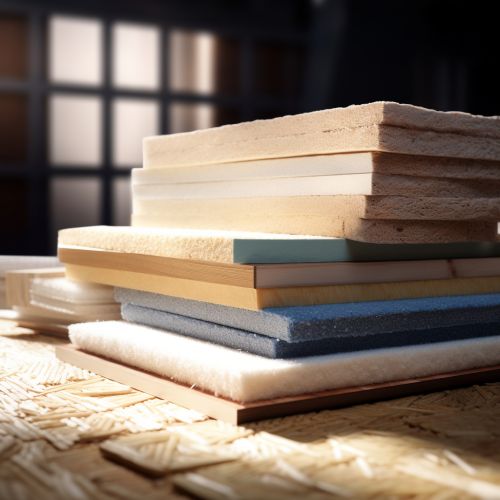Building insulation
Introduction
Building insulation is a critical component in the construction industry, providing thermal resistance to buildings. It is primarily used to reduce heat transfer by conduction, convection, and radiation to or from adjacent environments. Insulation materials work by slowing conductive heat flow and -- to a lesser extent -- convective heat flow. Radiant barriers and reflective insulation systems work by reducing radiant heat gain.


Types of Insulation
There are several types of insulation used in building construction, each with its unique properties and applications.
Blanket: Batt and Roll Insulation
Blanket insulation, which includes batt and roll insulation, is the most common type of insulation in residential construction. It is typically made from fiberglass, although it can also be made from mineral (rock and slag) wool, plastic fibers, and natural fibers such as cotton and sheep's wool.
Concrete Block Insulation
Concrete block insulation is used in new construction or major renovations. It can be applied to a block wall during construction or later using adhesive or mechanical fasteners. Some manufacturers incorporate foam beads or air into the concrete mix to increase its insulative properties.
Foam Board or Rigid Foam
Foam board or rigid foam insulation is typically more expensive than blanket insulation. However, it provides an insulation value of about R-4 per inch of thickness and can be used on unvented low-slope roofs, exterior walls, foundations, and more.
Insulating Concrete Forms (ICFs)
ICFs are a system of formwork for reinforced concrete that stays in place as a permanent interior and exterior substrate for walls, floors, and roofs. The forms are interlocking modular units that are dry-stacked and filled with concrete.
Loose-Fill and Blown-In Insulation
Loose-fill insulation consists of small particles of fiber, foam, or other materials. These small particles form an insulation material that can conform to any space without disturbing structures or finishes.
Reflective System
Reflective insulation system is a system that reduces the radiant heat gain into a building. This system consists of a highly reflective material that reflects radiant heat rather than absorbing it.
Rigid Fibrous or Fiber Insulation
Rigid fibrous or fiber insulation is typically used in areas that require high temperatures. This type of insulation is made from fiberglass or mineral wool and is commonly used in duct systems.
Sprayed Foam and Foamed-In-Place Insulation
Sprayed foam and foamed-in-place insulation can be applied using small spray containers or in larger quantities as a pressure sprayed (foamed-in-place) product.
Structural Insulated Panels (SIPs)
SIPs are prefabricated insulated structural elements for use in building walls, ceilings, floors, and roofs. They provide superior and uniform insulation compared to more traditional construction methods.
Insulation Materials
Various materials are used for insulation in buildings. The choice of material depends on factors such as location, building design, budget, and local building codes.
Fiberglass
Fiberglass is a common type of insulation material. It is made from fine glass fibers and is most commonly used in blanket insulation.
Mineral Wool
Mineral wool refers to several types of insulation. It can refer to glass wool (made from recycled glass), rock wool (made from basalt), or slag wool (made from steel mill slag).
Cellulose
Cellulose insulation is one of the most environmentally friendly forms of insulation. It is made from recycled paper products and treated for fire resistance.
Polyurethane Foam
Polyurethane foam is an insulation material that can be sprayed, foamed-in-place, injected, or poured. Its ability to expand and fill gaps and cracks make it an ideal air-sealing material.
Polystyrene
Polystyrene, or Styrofoam, is a type of plastic used for insulation. It is available in two types: expanded (EPS) and extruded (XPS). XPS is more expensive but also more resistant to moisture.
Natural Fibers
Natural fibers such as cotton, sheep's wool, straw, and hemp are used as insulation materials. These materials are eco-friendly and provide good thermal insulation.
Insulation Standards and Regulations
Building insulation is governed by various standards and regulations, which vary by country and region. These standards ensure that the insulation is safe, effective, and suitable for its intended use. In the United States, for example, the IECC and the U.S. Department of Energy set standards for insulation.
Environmental Impact
The production, use, and disposal of insulation materials can have significant environmental impacts. These impacts can be reduced by using materials with lower environmental impacts and by designing buildings to use less insulation through energy-efficient design.
